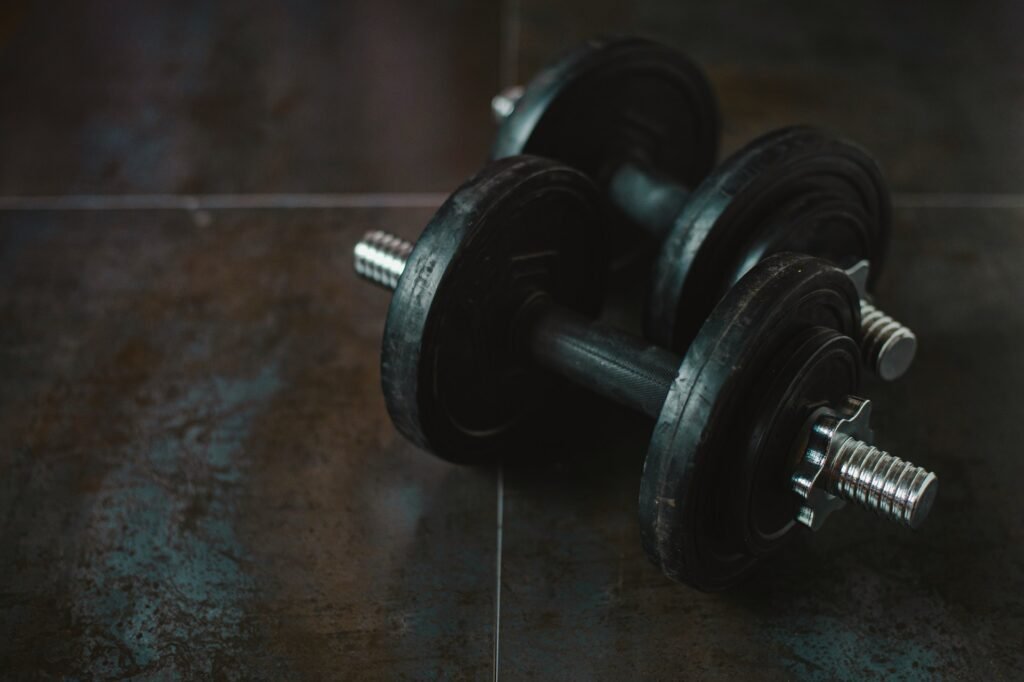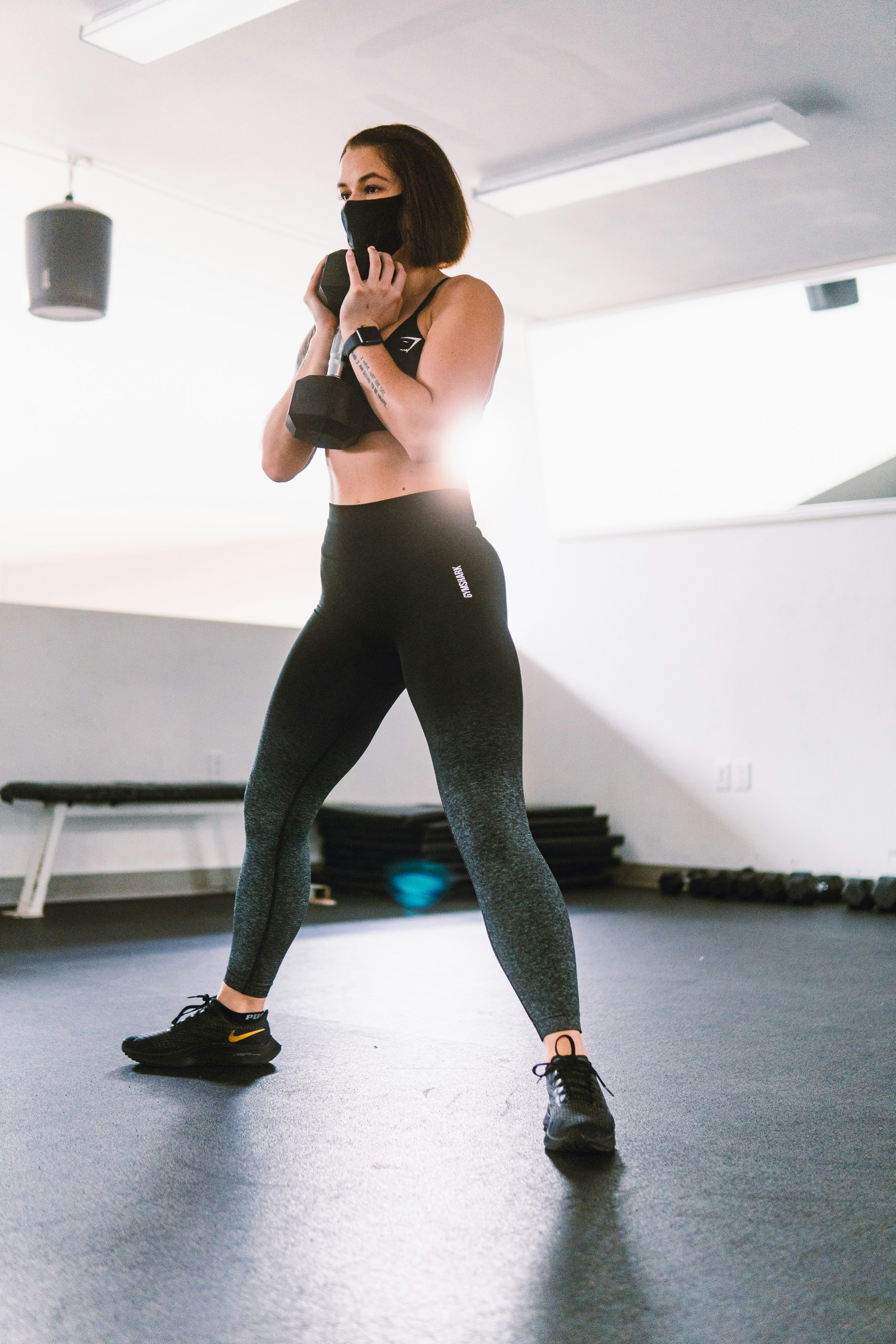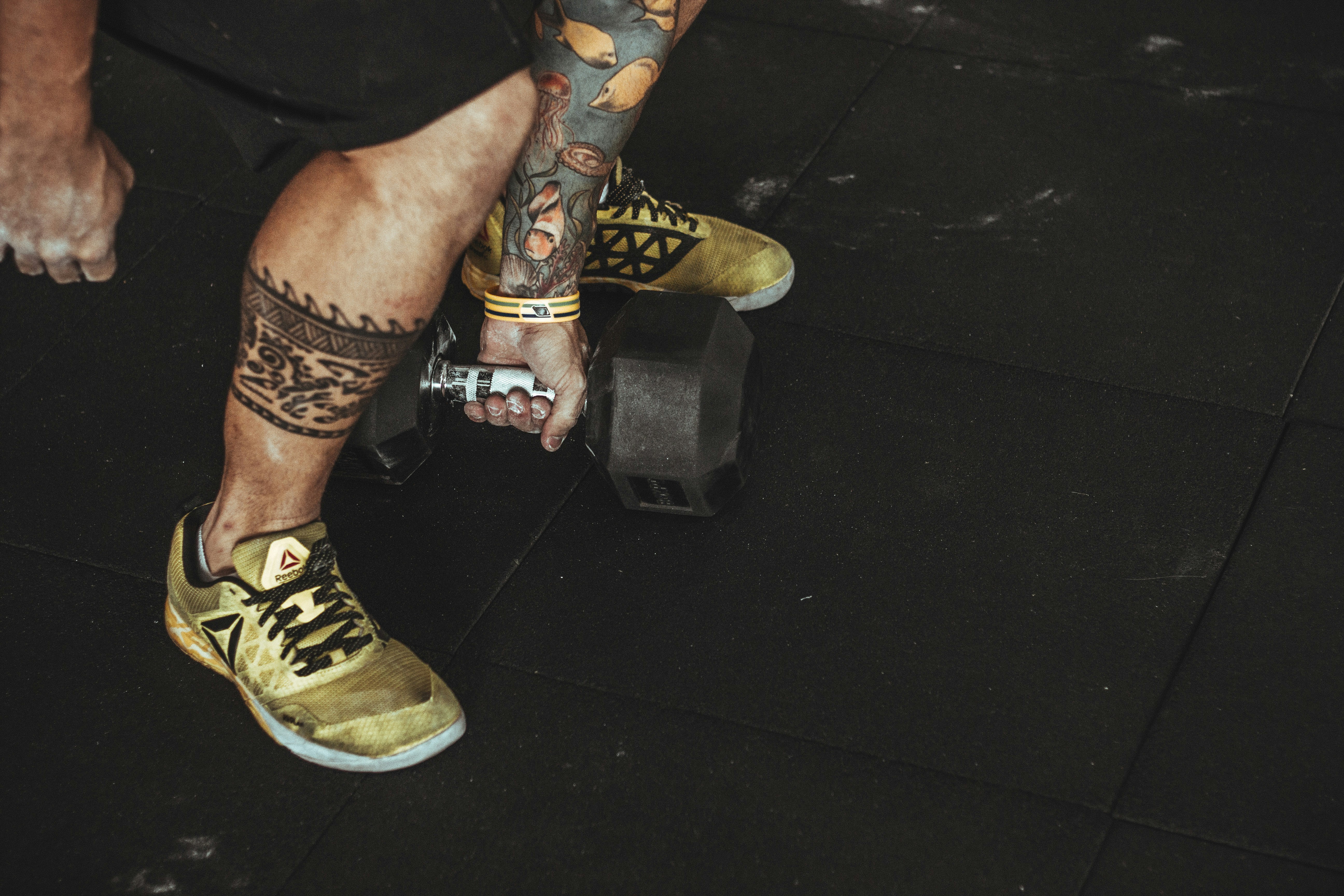
Photo by Egor Myznik on Unsplash
Dumbbells are an excellent choice for leg workouts at home. They offer versatility, allowing you to perform a wide variety of exercises that target all the major muscle groups in your legs. According to a 2021 study, using free weights like dumbbells can significantly increase muscle activation compared to machine-based exercises [^1^].
One of the main advantages of using dumbbells is their ability to engage stabilizing muscles, which helps improve balance and coordination. This not only enhances muscle strength but also reduces the risk of injury. Additionally, dumbbells are relatively affordable and require minimal space, making them a practical option for home workouts.
Dumbbell leg exercises can range from squats and lunges to deadlifts and calf raises. This variety allows you to effectively target different parts of your legs, including quadriceps, hamstrings, glutes, and calves. In fact, incorporating dumbbell exercises into your routine can lead to improved muscle symmetry and overall leg strength [^2^].
For more tips on integrating dumbbells into your workout routine, you might find our article on At Home Dumbbell Back Workout useful. Dumbbells are a versatile tool that can significantly enhance your fitness routine by offering a full-body workout experience right at home.
Advantages of Using Dumbbells for Leg Training
Dumbbells offer several valuable benefits when used for leg training. One of the main advantages is their versatility. Dumbbells allow for a wide range of exercises that target different parts of the leg muscles. You can perform squats, lunges, deadlifts, and more without needing bulky and expensive gym equipment. This makes them a cost-effective solution for at-home workouts.
A study highlighted that training with dumbbells leads to similar muscle activation in major muscle groups compared to other more expensive and space-consuming equipment like barbells or machines (source). This means you can achieve significant strength and muscle gains without needing a large space or equipment setup.
Another advantage is the improvement in balance and coordination. Training with dumbbells requires you to stabilize each weight individually, engaging your core and other stabilizing muscles more intensely. This can help improve overall balance and functional strength. This is particularly beneficial for enhancing sports performance and reducing injury risk.
Furthermore, dumbbell training allows for unilateral workouts, meaning you can work each leg independently. This approach helps in addressing muscle imbalances, ensuring both legs develop equally in strength and size.
Lastly, dumbbells are safer to use for certain exercises compared to barbells. If you lose your balance during exercises like lunges or step-ups, you can easily drop the dumbbells to avoid injury, unlike a barbell, which can be cumbersome and risky to handle alone.
Essential Dumbbell Leg Exercises

Photo by Matthew Sichkaruk on Unsplash
Working on your legs with dumbbells can be incredibly effective and versatile. Here are some essential exercises that can help you build strength and muscle:
Basic Exercises
- Goblet Squat: This exercise is great for beginners learning how to squat. By holding a dumbbell in front of you, it also challenges your core.
- Sets and reps: 3 x 8-12
- Technique: Hold the dumbbell with both palms under one of the weight’s ends (like a goblet), with feet shoulder-width apart. Squat down with a straight back, keeping your chest forward. Push through your heels to return to the starting position.
- Stat: Squats build your quadriceps and glutes, contributing to overall lower-body strength.
- Dumbbell Deadlift: Targeting your hamstrings and glutes, this exercise is a compound movement that also engages your core and upper back.
- Sets and reps: 4 x 8
- Technique: Stand with feet shoulder-width apart, dumbbell on the floor between them. Bend your knees, keep your back straight, and grasp the dumbbell. Stand up by driving your hips forward.
- Note: An effective deadlift can lift up to 1.5 times your body weight (MyProtein).
- Walking Lunges: These work on your quads, hamstrings, and glutes while also increasing your heart rate.
- Sets and reps: 3 x 15-20 per leg
- Technique: Step forward with one leg and bend both knees to lower your body. Push off the front leg to move forward and repeat with the other leg.
- Tip: Holding dumbbells adds resistance and increases muscle engagement.
- Glute Bridges: Aimed at the glutes and hamstrings, this exercise also strengthens your lower back.
- Sets and reps: 4 x 20
- Technique: Lie on your back with knees bent and feet flat. Place a dumbbell on your hips. Lift your hips toward the ceiling, squeeze your glutes, pause, and lower back down.
- Note: You can also perform this exercise on a stability ball for added difficulty.
Advanced Exercises
- Bulgarian Split Squat: This is a single-leg exercise that really tests your balance and leg strength.
- Sets and reps: 3 x 10-12 per leg
- Technique: With your back foot elevated on a bench, hold a dumbbell in each hand. Bend your front knee to lower yourself, then rise back up.
- Tip: Balance can be challenging; practice with no weight first if needed.
- Single-Leg Romanian Deadlift: Focused on the hamstrings and glutes, this exercise also improves balance.
- Sets and reps: 3 x 10-12
- Technique: Stand on one leg, holding a dumbbell in the opposite hand. Lean forward, lowering the dumbbell while extending your free leg backward, then return to standing.
- Fact: Romanian deadlifts help improve flexibility and muscle endurance.
- Calf Raises: Don’t neglect your calves; this exercise ensures your lower legs are str
- Sets and reps: 3 x 20
- Technique: Stand on the edge of a step with a dumbbell in each hand. Raise your heels until standing on your toes, pause, then lower back down.
- Insight: Strong calves contribute to better overall leg functionality and stability.
For a comprehensive leg workout, incorporate these exercises into your routine. If you are curious how different leg exercises compare, check our detailed comparison page on Goblet Squat vs. Barbell Squat.
Working out your legs helps maintain a balanced physique, and these exercises ensure you hit all muscle groups for optimal strength and stability.
Creating the Perfect At Home Leg Workout Space
Creating an effective workout space at home is essential for a productive leg day. Start by finding a spot with enough room for movement, ideally where you can extend your legs fully in any direction. Ensure the area is free from any hazards like loose rugs or furniture that might cause injury. If possible, use a non-slip mat to maintain stability during exercises.
Lighting is key for safety and to keep the energy high. Natural light is best, but if that’s not an option, opt for bright, overhead lighting. Ventilation is another consideration; proper airflow can make your workout more comfortable, especially during intense sessions.
Investing in a few pieces of equipment can significantly enhance your leg workouts. Dumbbells are versatile and can be used for a variety of leg exercises like squats and lunges. Resistance bands are also a great addition for targeting smaller muscles and adding variety to your routine. For those with more space and budget, items like kettlebells or a barbell set can offer even more options.
Finally, a good workout bench or a sturdy chair can serve multiple purposes, from stability during exercises like Bulgarian split squats to providing support during stretches. A wall mirror can help you monitor your form to ensure exercises are done correctly, reducing the risk of injury.
Remember, planning your workout in advance can help you use your space more effectively and ensure you’re hitting all the necessary muscle groups.
Weekly At Home Dumbbell Leg Workout Plan

Photo by Victor Freitas on Unsplash
Creating a weekly home dumbbell leg workout plan can help you achieve stronger, more toned legs. Here is a comprehensive and effective plan you can follow. Based on a 5-day split routine, this plan ensures you hit all major muscle groups while allowing optimal recovery time.
Day 1: Legs & Core
Exercises:
- Dumbbell Goblet Squats: 4 sets of 8-10 reps
- Dumbbell Stiff-Leg Deadlifts: 4 sets of 8-10 reps
- Dumbbell Rear Lunges: 4 sets of 8-10 reps each leg
- Dumbbell Frog Squats: 3 sets of 8-12 reps
- Dumbbell Calf Raises: 4 sets of 20 reps
- Weighted Crunches: 3 sets of 20 reps
- Side Planks: 3 sets of 20 seconds each side
Day 2: Upper Body
A well-balanced routine includes upper body exercises to maintain overall muscle symmetry and strength. You can view some at-home dumbbell shoulder workouts on our blog.
Day 3: Rest / Light Cardio
Take a rest day or engage in light cardio. Activities like walking or using a stationary bike are ideal for active recovery (source).
Day 4: Legs & Core
Exercises:
- Dumbbell Squats: 4 sets of 8-10 reps
- Dumbbell Deadlifts: 4 sets of 8-10 reps
- Dumbbell Split Squats: 3 sets of 8-12 reps each leg
- Dumbbell Hip Thrusts: 4 sets of 10-15 reps
- Dumbbell Calf Raises: 4 sets of 20 reps
- Dumbbell Side Bends: 3 sets of 15 reps each side
- Planks: 3 sets of 20 seconds
Day 5: Upper Body
On this day, focus again on your upper body to give your legs sufficient recovery time.
Day 6: Active Recovery / Optional Light Cardio
Perform light activities like yoga or a brisk 20-minute walk to promote blood flow and muscle recovery.
Day 7: Rest
Ensure full rest to allow your muscles to recover and grow.
Tips and Notes
- Consistency: Stick to your plan consistently for at least 12 weeks to see noticeable results.
- Progressive Overload: Gradually increase your weights or repetitions over time to keep challenging your muscles.
- Proper Form: Maintain good form to prevent injury.
- Documentation: Track your workouts to monitor progress and make adjustments as needed.
According to experts, splitting workouts between muscle groups ensures balanced training and avoids overworking any one area (source). This plan allows you to sculpt well-defined legs without stepping foot in a gym.
Safety Tips and Common Mistakes to Avoid
When it comes to working out with dumbbells at home, safety should be your top priority. Here are some essential safety tips and common mistakes to avoid to ensure a safe and effective workout:
- Proper Form and Technique: Always focus on maintaining proper form and technique during exercises. Poor form can lead to injuries, particularly in the knees, back, and joints. For example, when performing squats, ensure your knees do not cave inward and your back remains straight. Using a mirror can help you monitor and correct your form.
- Warm-Up and Cool Down: Before starting your workout, it’s crucial to warm up your muscles to prepare them for the strain of exercise. A 5-10 minute warm-up with light cardio or dynamic stretches can significantly reduce the risk of injury. Similarly, cool down with stretches to maintain flexibility and muscle health.
- Start with Light Weights: Especially for beginners, starting with light weights can help you master the exercises and prevent strain. Gradually increase the weights as you become more comfortable and gain strength. Using overly heavy weights from the start can compromise your form and lead to injury.
- Clear Workout Space: Ensure your workout area is free from obstacles to prevent trips and falls. This is particularly important if you’re working out in a small space at home.
- Avoid Rushing Exercises: Perform each exercise slowly and with control. Rushing through workouts can result in mistakes and injuries. Remember, quality over quantity is key in achieving effective results and maintaining safety (BLR, 2023) (source).
- Listen to Your Body: Pay attention to your body’s signals. If you feel pain (as opposed to the usual discomfort of exercise), stop immediately. Continuing to exercise through pain can worsen the injury.
By following these tips and avoiding common mistakes, you can create a safe and productive environment for your at-home dumbbell workouts. For more insights on maintaining your fitness and avoiding injuries, you can check out our article on low-impact cardio for bad knees.
Maintaining proper safety protocols not only enhances your workout effectiveness but also ensures long-term health and well-being.
Wrapping Up: Optimize Your Fitness Journey at Home
To make the most of your home workout routine, it’s worth considering a few key strategies to keep you on track and motivated. One effective approach is to maintain a fitness journal. This practice allows you to identify patterns in your training and make necessary adjustments to enhance your results.
Additionally, it’s important to set up a space at home that is conducive to working out. Ensure you have enough room to move freely and that your workout area is free from distractions. Proper lighting and ventilation can also make your exercise time more enjoyable and effective.
Properly equipping your home gym with dumbbells of various weights and a sturdy mat can also be beneficial. This ensures you can perform a range of exercises safely and effectively. Don’t forget to incorporate a mix of exercises to target different muscle groups for a balanced routine.
Finally, always remember to prioritize safety by using proper form and avoiding common mistakes, such as lifting weights that are too heavy or neglecting warm-ups and cool-downs. Refer to our Safety Tips and Common Mistakes to Avoid section for more information.
By following these tips, you’ll be well on your way to achieving your fitness goals from the comfort of your home. Setting a regular schedule, tracking your progress, and ensuring you have the right space and equipment can make all the difference in your at-home workout success.
[^1]: Kristen Webb Wright, “How to Start a Fitness Journal: Tips, Templates, and Prompts,” Day One Blog. Link.